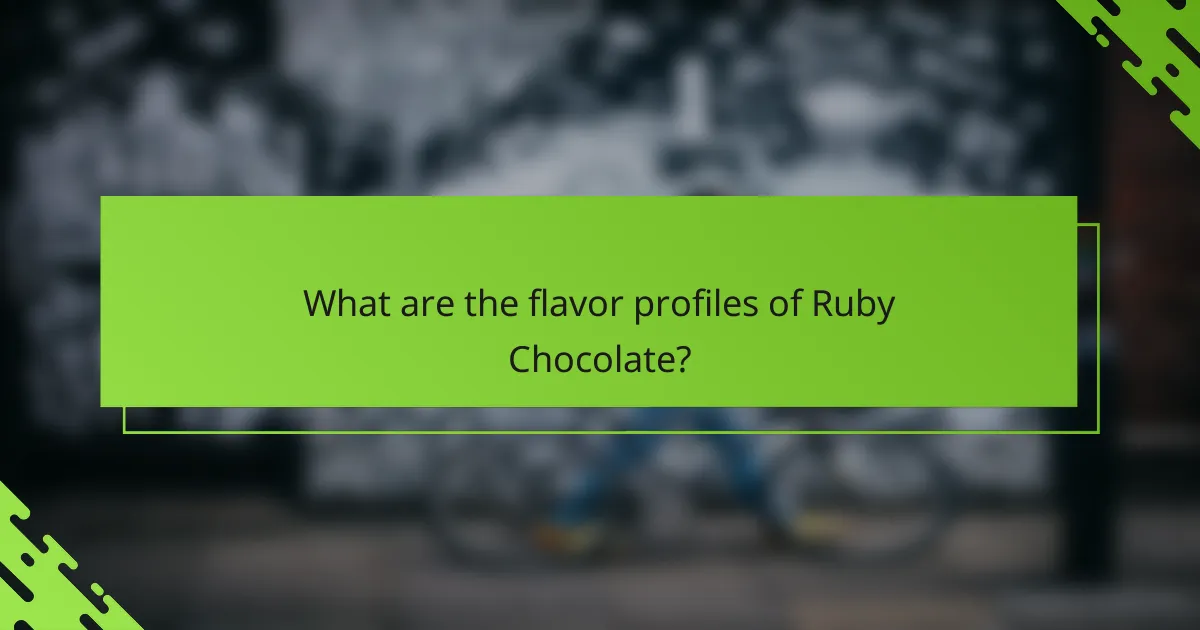Ruby chocolate is a captivating treat that stands out with its unique pink hue and fruity flavor profile, achieved through a special processing of cacao beans. This innovative chocolate variety combines traditional techniques with modern methods, offering a delightful taste experience that differentiates it from classic dark and milk chocolates. Its growing popularity has made ruby chocolate a trendy choice, readily available in stores and online across the USA.

How is Ruby Chocolate made?
Ruby chocolate is created through a unique process that involves specific cacao beans, which are treated to enhance their natural fruity flavors and distinctive pink hue. This chocolate type combines traditional chocolate-making techniques with innovative processing methods to achieve its signature taste and appearance.
Extraction from cacao beans
The extraction of ruby chocolate begins with specially selected cacao beans, primarily from Ecuador, Brazil, and the Ivory Coast. These beans are harvested at peak ripeness to ensure optimal flavor development. After harvesting, the beans undergo fermentation, which is crucial for developing the fruity notes characteristic of ruby chocolate.
During fermentation, the beans are placed in shallow containers and covered with banana leaves for several days. This process not only enhances the flavor but also contributes to the color development of the beans, setting the stage for the unique ruby chocolate experience.
Processing methods
Once the cacao beans are fermented, they are dried and roasted to bring out their flavors. The roasting process is carefully controlled, as over-roasting can diminish the fruity notes that ruby chocolate is known for. After roasting, the beans are cracked and winnowed to separate the nibs from the shells.
The nibs are then ground into a chocolate liquor, which is blended with sugar and cocoa butter. The specific ratios of these ingredients can vary, but the goal is to maintain the fruity essence while achieving a smooth texture. This mixture is then conched, a process that refines the chocolate and enhances its flavor profile.
Color development techniques
The distinctive pink color of ruby chocolate is achieved through a combination of natural pigments found in the cacao beans and specific processing techniques. During the fermentation stage, the beans develop anthocyanins, which are responsible for the pink hue. These pigments are sensitive to pH levels and temperature, so careful monitoring is essential during processing.
After conching, the chocolate is tempered to stabilize the cocoa butter crystals, ensuring a glossy finish and a satisfying snap. The final product is then molded and cooled, resulting in the vibrant ruby chocolate that has gained popularity as a trendy option in the confectionery market.

What are the flavor profiles of Ruby Chocolate?
Ruby chocolate offers a unique flavor profile characterized by its fruity notes and balanced sweetness. This chocolate variety, made from specially processed cocoa beans, provides a distinct taste experience that sets it apart from traditional dark and milk chocolates.
Fruity notes
Ruby chocolate is known for its vibrant fruity notes, often reminiscent of berries and tart fruits. This flavor profile is achieved through the specific processing of the cocoa beans, which preserves their natural fruitiness. The result is a refreshing taste that can enhance desserts and confections.
When pairing ruby chocolate, consider complementing its fruity flavors with ingredients like citrus zest or berry compotes. This can elevate the overall taste experience and highlight the chocolate’s unique characteristics.
Sweetness level
The sweetness level of ruby chocolate typically falls between that of milk and dark chocolate, making it appealing to a wide range of palates. It generally contains a moderate amount of sugar, which balances its fruity acidity without overwhelming the taste buds.
When using ruby chocolate in recipes, keep in mind its sweetness. Adjust other sweet ingredients accordingly to maintain a harmonious flavor balance in your dishes.
Texture characteristics
Ruby chocolate boasts a smooth and creamy texture, similar to milk chocolate, which enhances its mouthfeel. This texture is achieved through the careful selection and processing of cocoa solids and cocoa butter, resulting in a luxurious eating experience.
In baking, ruby chocolate can be used in various forms, such as chips or bars, and melts easily, making it suitable for ganaches and coatings. Its texture allows it to blend well with other ingredients, creating delightful treats.

Where can you find Ruby Chocolate in the USA?
Ruby chocolate can be found in various locations across the USA, including major chocolate brands, specialty stores, and online retailers. Its unique color and fruity notes have made it a trendy option, leading to its availability in both physical and digital marketplaces.
Major chocolate brands
Many well-known chocolate brands have embraced ruby chocolate, offering it in various forms such as bars, truffles, and confections. Brands like Lindt and Ferrero have introduced ruby chocolate products that highlight its distinct flavor profile and visual appeal. Look for these offerings in supermarkets and specialty grocery stores nationwide.
When purchasing from major brands, check for seasonal releases or limited editions, as these can provide unique variations of ruby chocolate that may not be available year-round.
Specialty stores
Specialty chocolate shops often carry ruby chocolate, providing a curated selection of high-quality products. These stores may offer artisanal brands that focus on unique flavor combinations and premium ingredients. Visiting local chocolatiers can also provide opportunities to taste and discover new ruby chocolate creations.
Consider asking staff for recommendations or trying sample tastings to find the best ruby chocolate options that suit your palate.
Online retailers
Online shopping has made it easier to find ruby chocolate from various sources, including dedicated chocolate websites and larger e-commerce platforms. Websites like Amazon and specialty chocolate retailers often stock a range of ruby chocolate products, making it convenient to compare prices and options from the comfort of your home.
When ordering online, be mindful of shipping costs and delivery times, especially if you’re purchasing for a special occasion. Check customer reviews to ensure the quality of the ruby chocolate before making a purchase.

Why is Ruby Chocolate trending?
Ruby chocolate is trending due to its unique color and fruity flavor profile, appealing to consumers seeking new experiences in chocolate. Its vibrant hue and taste differentiate it from traditional dark, milk, and white chocolates, making it a popular choice among food enthusiasts and social media influencers.
Social media influence
Social media platforms have played a significant role in the rise of ruby chocolate’s popularity. Influencers and food bloggers showcase visually appealing desserts and treats made with ruby chocolate, driving consumer interest and engagement. The striking pink color makes it highly shareable, encouraging users to post and promote their culinary creations.
Hashtags related to ruby chocolate often trend, creating a sense of community among fans. This visibility not only boosts sales but also inspires brands to innovate and create new ruby chocolate products, further fueling the trend.
Consumer preferences
Today’s consumers are increasingly adventurous and willing to try new flavors, which has contributed to the popularity of ruby chocolate. Many people are drawn to its fruity notes, which offer a refreshing alternative to traditional chocolate varieties. This shift in preferences reflects a broader trend towards unique and artisanal food products.
Additionally, the appeal of ruby chocolate aligns with the growing demand for visually stunning food items, as consumers often seek out products that are both delicious and Instagram-worthy. Brands that capitalize on these preferences can attract a loyal customer base.
Innovative recipes
Ruby chocolate’s versatility allows for a wide range of innovative recipes, from desserts to savory dishes. Chefs and home bakers alike experiment with ruby chocolate in cakes, mousses, and even sauces, enhancing traditional recipes with its distinct flavor and color. For example, ruby chocolate ganache can elevate a simple tart into a gourmet dessert.
Moreover, ruby chocolate can be paired with various ingredients, such as berries, citrus, and nuts, to create exciting flavor combinations. This adaptability encourages culinary creativity and invites consumers to explore new ways to enjoy this trendy chocolate.

What are the benefits of Ruby Chocolate?
Ruby chocolate offers a unique combination of visual appeal, versatility in desserts, and potential health benefits. Its distinct color and fruity flavor profile make it a trendy option for both consumers and chefs.
Unique visual appeal
Ruby chocolate stands out with its vibrant pink hue, which is achieved through a specific processing method of cocoa beans. This eye-catching color can enhance the presentation of various desserts, making them more attractive to consumers.
Using ruby chocolate can elevate the aesthetic of traditional treats like cakes, pastries, and chocolates, appealing especially to those seeking Instagram-worthy desserts. Its unique shade can also complement a variety of color palettes in culinary presentations.
Versatility in desserts
Ruby chocolate can be used in a wide range of desserts, from mousses and ganaches to cookies and ice creams. Its fruity notes pair well with various flavors, including berries, citrus, and even spices, allowing for creative combinations.
When baking, ruby chocolate can replace milk or dark chocolate in recipes, providing a new twist on classic favorites. Its melting properties are similar to other chocolates, making it easy to incorporate into both baked goods and confections.
Potential health benefits
Ruby chocolate contains cocoa solids, which are known for their antioxidant properties. These antioxidants may contribute to heart health and overall well-being when consumed in moderation.
While ruby chocolate is still a sweet treat, it can be a slightly better option compared to traditional milk chocolate due to its higher cocoa content. However, it’s important to enjoy it as part of a balanced diet to maximize its benefits without excessive sugar intake.

How does Ruby Chocolate compare to other chocolates?
Ruby chocolate stands out from other chocolates due to its unique color and fruity flavor profile. Unlike traditional chocolates, ruby chocolate offers a blend of sweetness and tartness, making it a trendy option among consumers seeking something different.
Milk chocolate comparison
Milk chocolate is known for its creamy texture and sweet flavor, primarily derived from milk solids and sugar. In contrast, ruby chocolate has a fruitier taste with a slight tartness, providing a refreshing twist. While milk chocolate typically contains around 10-20% cocoa solids, ruby chocolate usually features a similar cocoa content but with added berry flavor notes.
Dark chocolate comparison
Dark chocolate is characterized by its rich, intense cocoa flavor and lower sugar content. Ruby chocolate, while still cocoa-rich, incorporates fruity flavors that lighten its taste profile. Dark chocolate often contains 50-90% cocoa solids, whereas ruby chocolate generally falls within the 30-40% range, making it sweeter and more approachable for those who prefer less bitterness.
White chocolate comparison
White chocolate lacks cocoa solids, relying on cocoa butter, sugar, and milk for its creamy sweetness. Ruby chocolate, however, includes cocoa solids, giving it a distinct chocolate flavor alongside its fruity notes. While white chocolate is often criticized for being overly sweet, ruby chocolate balances sweetness with a hint of tartness, appealing to those who enjoy a more complex flavor experience.